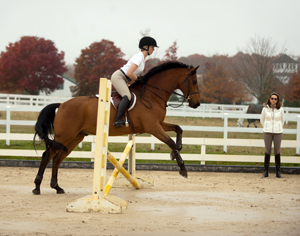Trotting fences smoothly is a skill that sounds easier than it is?and it’s also a more valuable element in your training tool kit than you might realize. Judges require trot jumps in equitation, hunter derbies and handy-hunter classes. But even if you show in a discipline that doesn’t require them, you’ll find this skill useful. Because the trot is a two-beat rhythm and is slower than the canter, you can more easily master coordination of your aids to regulate your horse’s speed, rhythm and balance while in it. If he tends to rush the jumps, learning to re-establish balance and control in the approach and maintain it all the way to takeoff at the trot will prepare you for doing the same in the canter. It also helps with gymnastic work—many gymnastic distances can be set for a trot-in approach.

Ideally, in the approach to a trot jump you establish a steady, even rhythm, closing your hip angle slightly so you won’t interfere with your horse when he leaves the ground. He trots all the way to the base of the jump without breaking into canter, slowing to walk or refusing. Just as in a good canter jump, he arrives at the center of the jump on a straight line and takes off “out of stride,” neither leaving out a stride nor making an awkward three-legged jump. Because you and he approach the fence in balance, maintaining a good rhythm, the resulting arc in the air is perfectly centered, with its highest point directly over the jump.
Producing such an ideal trot jump takes practice. I’m often surprised when new horses come to my barn who don’t seem comfortable trotting fences. They break into the canter in the last stride before takeoff, jump awkwardly out of rhythm or even refuse. In some cases, these problems result from poor balance or timing. In others, the horse may be confused by the rider’s aids. Some riders have trouble asking their horses to wait for the jump without using too strong a contact or being rigid in their hands.
Balance and timing can be more difficult in the trot for riders, as well. Stabilizing your position is easier in a full- or half-seat at the canter than in the rising trot, where your position is constantly changing. Some riders find it easier to approach jumps in the sitting trot, but that can be challenging, too, as horses may interpret the feeling of the rider’s seat as a cue to canter. Ideally, you should learn how to trot to fences in both sitting and rising trot, particularly if you show equitation classes, in which judges sometimes specify one or the other?or both! At first, though, experiment to find what works best for you and your horse and stick to that method until your trot jumps are solid.
I use a gradual system for teaching horses and riders to trot fences. It starts with getting your horse comfortable trotting ground poles, then jumping a single crossrail with placing poles on the takeoff and landing sides. After that you’ll work on trotting into a three-fence gymnastic line and cantering out. Finally, you’ll test your horse and yourself by trotting into a line of two fences and cantering out, then cantering into the same line and trotting out in the other direction. Depending on how comfortable you and your horse are, work your way through the following exercises over a series of several sessions. Then practice them frequently between shows to keep your skills sharp.
For more on this, see “Master the Trot Fence” in the April 2012 issue of Practical Horseman Magazine.










